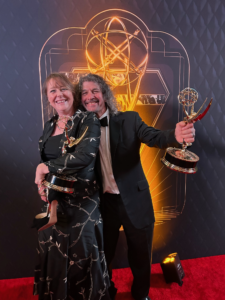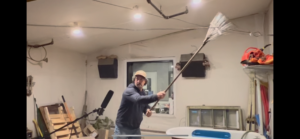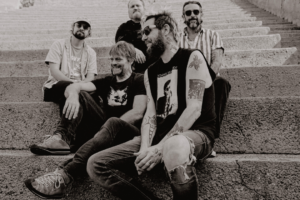
Take one empty warehouse with leaky walls at the Hat Factory in Peekskill, build it out into a sound-proofed, acoustically pleasing audio space, fill it with stages, control and editing rooms, and all manner of sound effects, and what have you got? The answer is Alchemy Post Sound (APS), an award-winning Foley facility that supplies audio enhancement and texture to big-budget, high-profile films and television series that you might well have seen.
How about season two of The Bear – all that slicing, chopping, mixing and stirring? Or the bone- crunching, gory sound in Prey? APS has recently won Emmys for its contributions to both of these, and a wall of other awards for supplying “complex sounds from the small intricate clock-work clicks of a watch to the massive earth-shattering debris of an explosion.”
Run by husband-and-wife team Andrea and Leslie Bloome and partner Ryan Collison, the Peekskill business opened some 10 years ago, growing out of Leslie’s decades-long experience in the world of Foley. “I studied music at college and wanted to become a session musician,” he said. “I played bass, some guitar and percussion, toured with the Box Tops and the Drifters, and on cruise ships. Out of the blue, I was invited to be part of a loop group session on a kickboxing film. The owners of the studio took a liking to me and asked if I would like to “give this Foley thing a go.” As a musician, I found it a natural transition from music to creating sounds for film.”
Leslie soon became a full-time Foley artist, working freelance for a wide range of studios in Los Angeles and San Francisco. He and Andrea were married in Los Angeles but Leslie grew up in Peekskill and needed to move back to help support his mother.
In New York, Leslie continued as a freelance Foley artist, working at many post-production studios until, on the recommendation of a client, he retrofitted his home studio into a Foley stage. It was a good short-term solution but eventually a real, independent facility became necessary. New York spaces were far too expensive, hence the launch in Peekskill in 2013. APS now employs 12 full-time staff – editors, mixers and artists – with Andrea as CEO and Leslie as lead Foley artist. “I wear a lot of other hats too.”

Foley work is the precise, interconnected, intricately detailed business of adding subtle sound enhancement to the story. Along with dialogue, music, sound design and background sound effects, Foley adds the sound of the actors’ movements. “Helping glue all these other sound elements together in the final sound mix” is how Bloome describes it. (Foley is named after Jack Foley, who is credited with developing a unique method of performing sound effects live, synchronized with the picture during post-production.)
A tour of APS reveals two control rooms, the live “big room” (a place to make interim sounds, filled with chairs, dishes, shoes and much more), an ADR (automated dialogue replacement) stage, and the main Foley stage — another large space complete with multiple surfaces for walking on, like gravel, grass, concrete and steel. There’s also a splash pit, a bathtub, myriad door handles, boxes of cereal, even fake guns used to make the sounds of weapons coming out of holsters and so on.
“Every sound we create is specific to one particular frame in time,” Leslie adds, explaining the nuances of depth of field, precision synchronizing and layering. “The bad guys’ guns always need to sound louder and heavier than the good guys’,” he reveals, describing the additional sounds APS creates.
It’s an eye-opener, and once you listen to and observe what Foley adds, you’ll never watch TV and movies the same way again. But that’s the joy of the work. And so is the discovery that not all of Hollywood’s magic emerges from Tinseltown.






